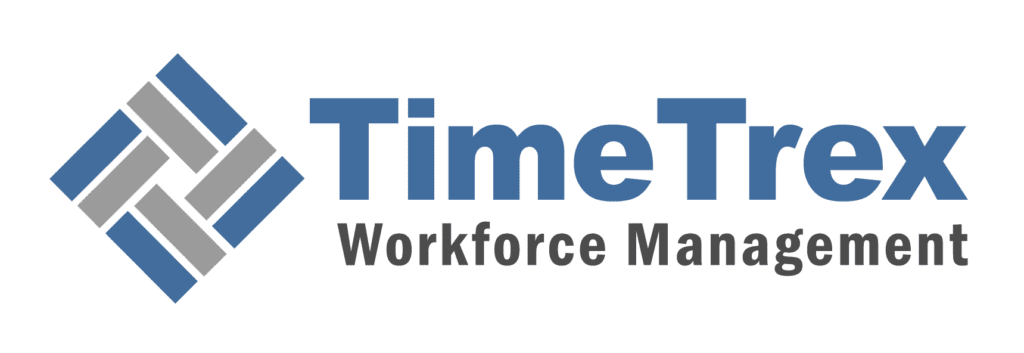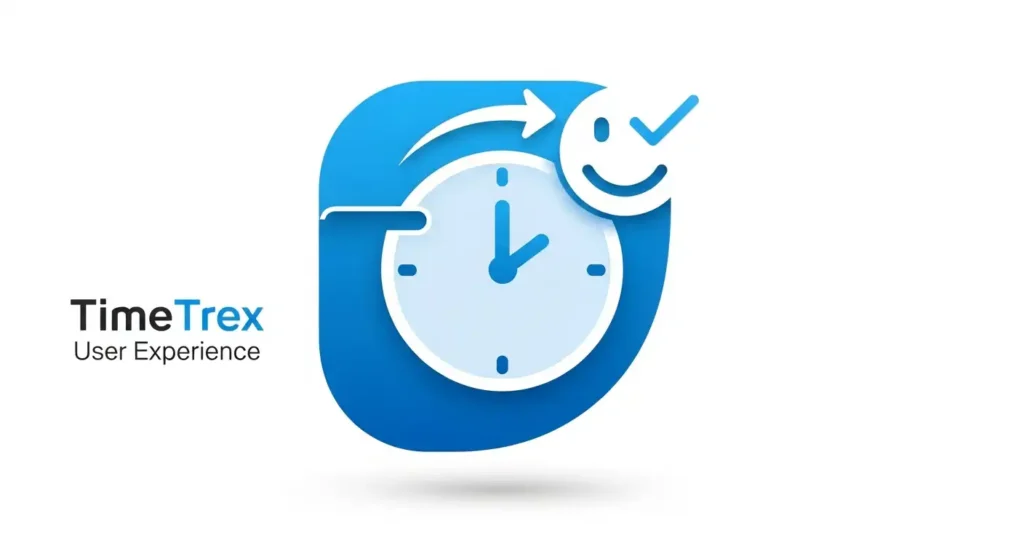
TimeTrex User Experience Review
Discover the truth about the TimeTrex user experience (UX) and its acclaimed user-friendly UI. This in-depth analysis for businesses explores whether TimeTrex is the best easy-to-use scheduling app with integrated payroll and workforce management. We evaluate its newly modernized mobile app, employee self-service portal, and overall platform usability to help you decide if its powerful, all-in-one system is the right fit for your complex business needs. Read on for a deep dive into TimeTrex's UI, features, and user feedback.
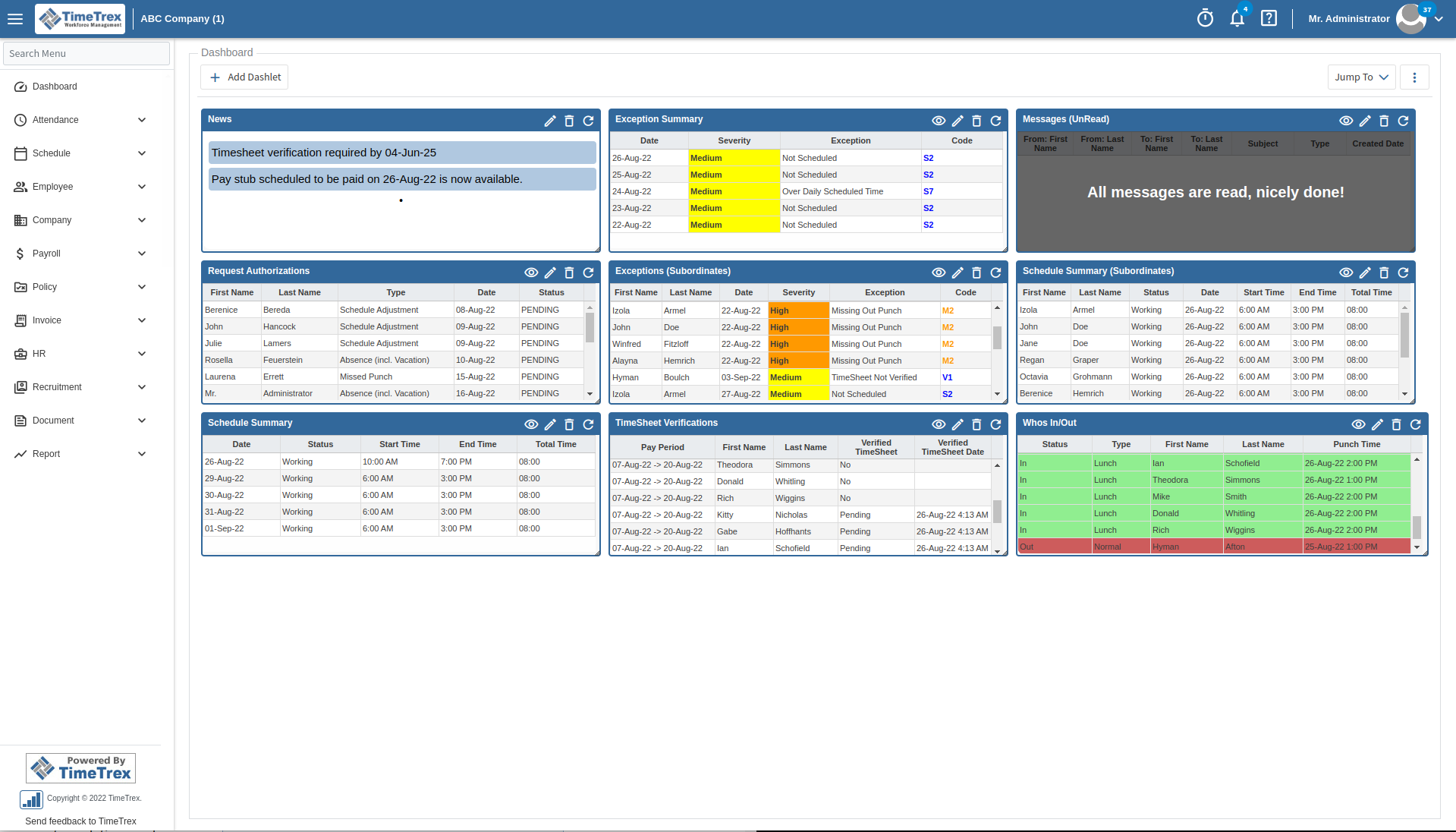
On This Page
- TL:DR
- The TimeTrex UI Philosophy: An Architecture of Integrated Complexity
- Deconstruction of the Navigational Framework and Core Interface
- The Employee Journey: A Mobile-First Self-Service Experience
- The Power User Experience: Managerial Control and Administrative Complexity
- A Synthesis of Market Feedback on Usability
- Competitive UX Benchmark: TimeTrex in the Market Context
- Final Assessment and Strategic Recommendations
TL:DR
This report provides a comprehensive, multi-faceted analysis of the user interface (UI) and user experience (UX) of the TimeTrex workforce management platform. The central finding is that TimeTrex presents a powerful usability proposition: its all-in-one architecture—integrating time and attendance, scheduling, payroll, and HR—is both its greatest strength and the source of its comprehensive feature set. For employees, the experience is modern and empowering, with a newly updated, feature-rich mobile app and self-service portal. For managers and administrators, the platform's immense power is unlocked through a detailed configuration process. The claim that TimeTrex is "easy to use" is conditional; ease is not found in an overly simplistic interface but is the long-term result of a meticulous configuration that automates complex business rules and ensures data integrity. TimeTrex is strategically recommended for organizations with complex scheduling or compliance needs (like healthcare, manufacturing, or retail) that value long-term control, data integrity, and operational efficiency.
The TimeTrex UI Philosophy: An Architecture of Integrated Complexity
The user experience of any software platform is a direct reflection of its underlying architectural philosophy. In the case of TimeTrex, its UI and UX are fundamentally shaped by a core design choice: the creation of a truly all-in-one workforce management system built upon a single, unified database. This architectural decision is the primary driver of the platform's value, enabling seamless workflows impossible in fragmented systems. However, this same choice introduces an integrated complexity that defines the user's interaction, creating a powerful yet demanding experience.
From Legacy to Modern: The Recent UI Overhaul
To evaluate the current TimeTrex user experience, it's essential to acknowledge its recent evolution. The company undertook a major UI overhaul, driven by extensive customer feedback, migrating from an older system to a modern, intuitive, and mobile-friendly interface. This transition signals a clear commitment to prioritizing the user experience. According to TimeTrex's recent UI update announcements, the redesign focused on fundamental workflow enhancements, including a cleaner layout, a collapsible main menu, quick-action buttons, and a powerful drag-and-drop scheduler to reduce clicks and lower the learning curve.
The All-in-One Architectural Advantage and its UX Trade-offs
Unlike competitors that rely on "bolt-on integrations," TimeTrex is a single, holistic ecosystem where Time & Attendance, Scheduling, Payroll, and HR are native components sharing one database. This design provides a profound advantage. As noted in resources about the best payroll software solutions, because the native payroll engine draws data directly from the time and attendance modules, entire categories of costly errors are eliminated. This makes processing payroll exceptionally efficient. However, this power comes with a necessary UX trade-off. To be a true all-in-one solution, the interface must provide control over an immense breadth of functionality—over 70 distinct features. This functional depth, while empowering for administrators, is the reason the initial setup is more involved than in simpler systems. The very architecture that simplifies payroll makes the initial setup a detailed process of configuring business rules and policies.
Deconstruction of the Navigational Framework and Core Interface
A detailed analysis of the TimeTrex web interface reveals a structured and consistent, if functionally dense, design. The platform's navigational framework is built around core components that remain persistent, providing a predictable user experience once the initial learning curve is overcome.
The Core Navigational Structure
The TimeTrex UI is organized around three primary navigational components, detailed in the official help guides:
- Header Bar: A persistent top bar for universal actions like Punching In/Out, notifications, help, and profile access.
- Main Menu: A comprehensive, collapsible left-side menu listing all major modules, with flexible display modes to maximize screen space.
- Button Bar: A dynamic, context-sensitive bar below the header that displays relevant actions (New, Edit, Save, etc.) for the current page.
The Dashboard as a Centralized Hub
Upon logging in, users see the Dashboard, a customizable command center. It's constructed using modular components called "Dashlets," which can be added via a wizard to display everything from company news to real-time KPIs. The interface supports drag-and-drop functionality, allowing users to rearrange and resize Dashlets for a personalized layout. This high degree of customizability is a powerful feature for experienced users who want to build data-rich views.
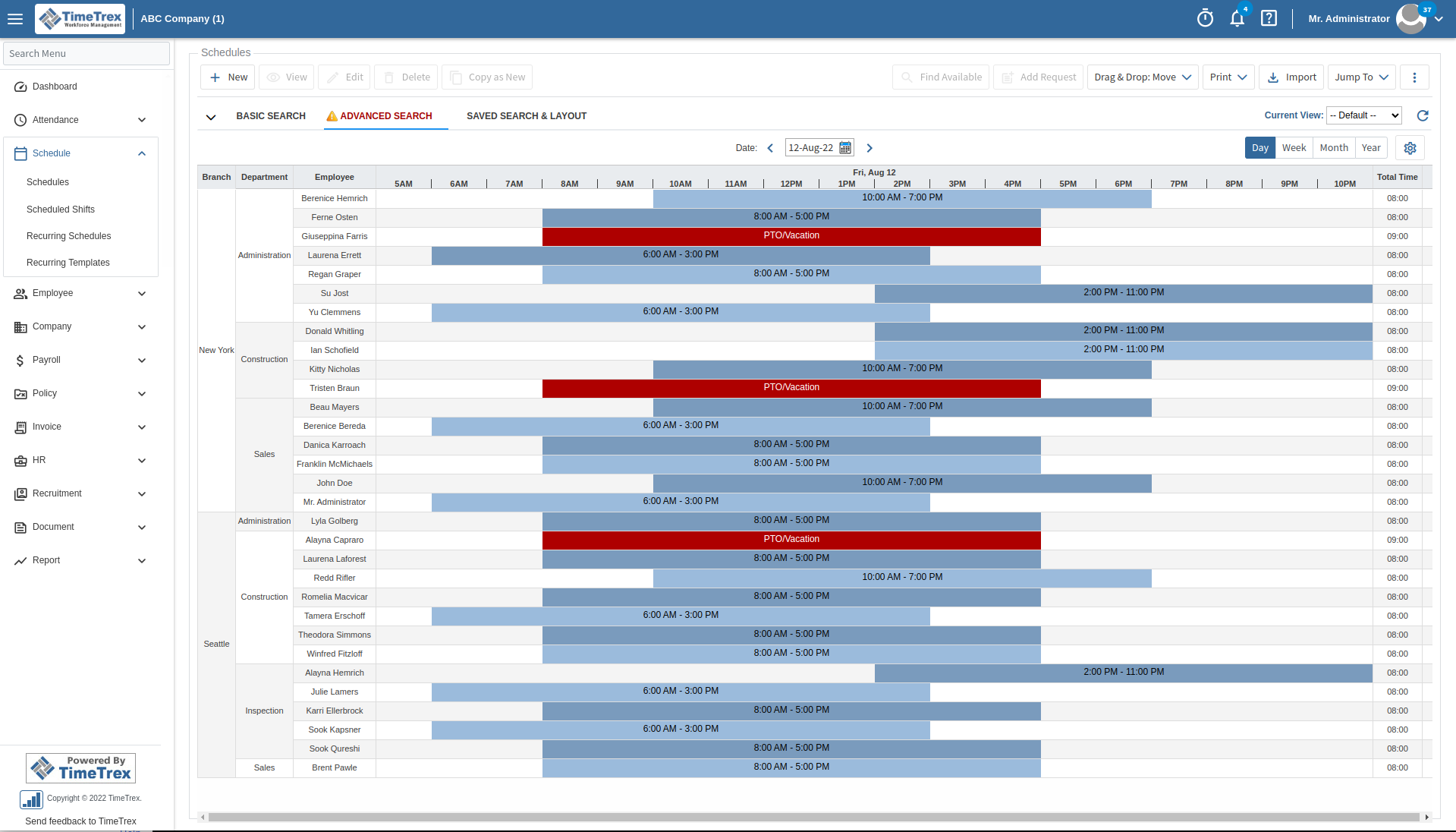
Standardized Operations and Data Interaction
To manage its comprehensive feature set, TimeTrex employs a standardized model for data interaction. The four basic operations—View, New, Edit, and Delete—are applied consistently across most modules. Adding or editing information typically opens an "inset page" with multiple tabs to organize complex data entry, such as the numerous fields required when adding a new employee. This tabbed approach prevents overwhelming single-page forms while keeping data organized.
The Employee Journey: A Mobile-First Self-Service Experience
The user experience for a standard, non-managerial employee is arguably the most polished aspect of the TimeTrex platform. The design is centered on empowerment and autonomy, delivered through a comprehensive Employee Self-Service (ESS) portal and a modern, capable mobile application.
Empowerment through the ESS Portal
The Employee Self-Service portal is a cornerstone of the TimeTrex UX, allowing employees to manage their work-related information independently. They can track hours, view timesheets, monitor PTO balances, update personal information, submit time-off requests, and access historical pay stubs and tax forms. This level of transparency and control fosters autonomy, enhances engagement, and significantly reduces the administrative burden on HR.
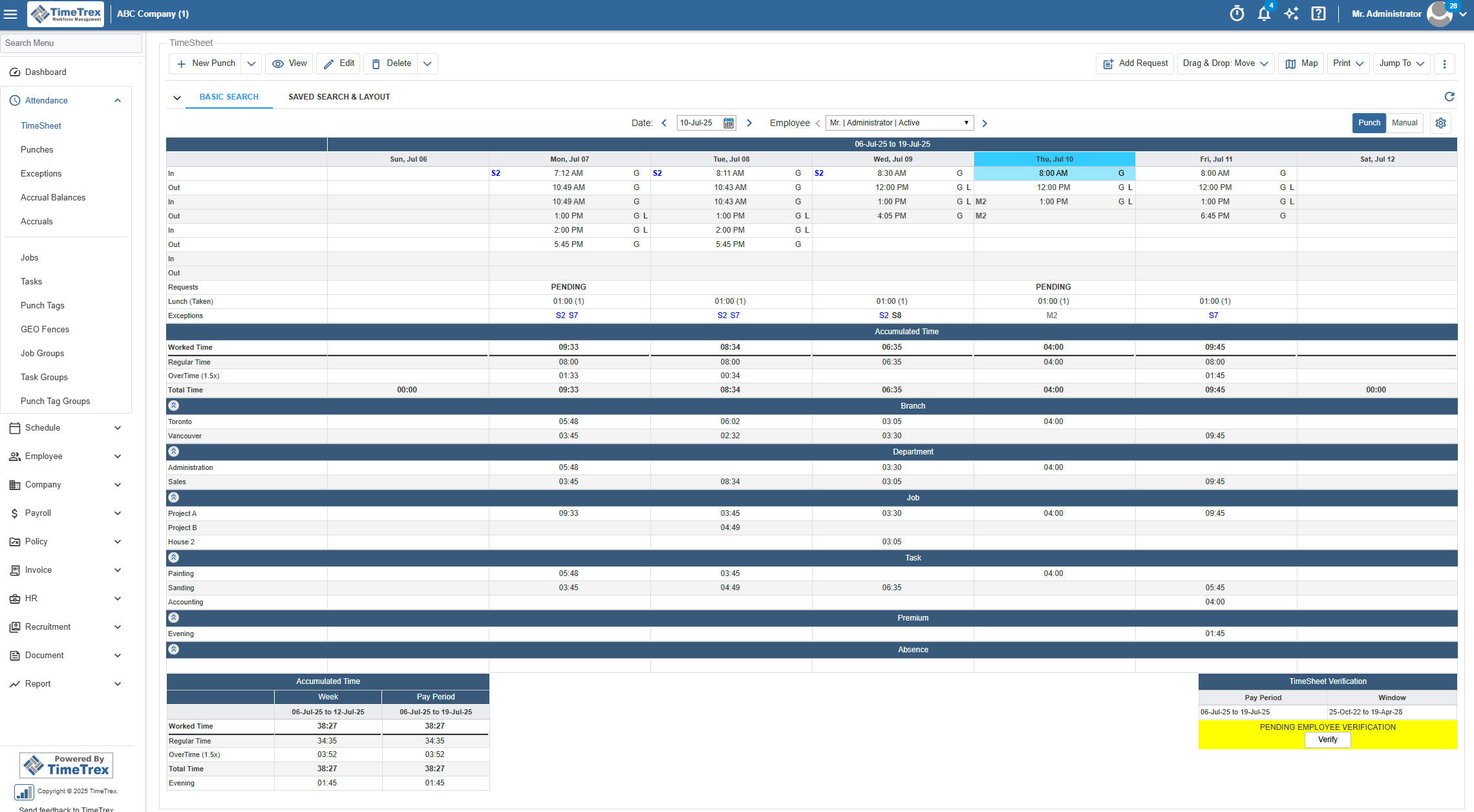
The Modern Mobile App Experience
TimeTrex's newly modernized mobile app serves as a primary tool for the modern workforce. With a sleek, updated user interface, it extends the full power of the ESS portal to employees' fingertips, featuring technologically advanced capabilities ideal for remote, field-based, and deskless workers.
- Flexible and Secure Clock-In Methods: The app supports simple mobile punch, shared tablet kiosks, and advanced biometric facial recognition to eliminate "buddy punching."
- Robust Location Verification: GPS and geofencing capabilities record punch locations and enforce virtual boundaries, providing verifiable proof of presence.
- Critical Offline Functionality: As highlighted in reviews of the best attendance tracking apps, the app's offline mode is a standout feature. It captures and stores time data without an internet connection, syncing automatically once connectivity is restored.
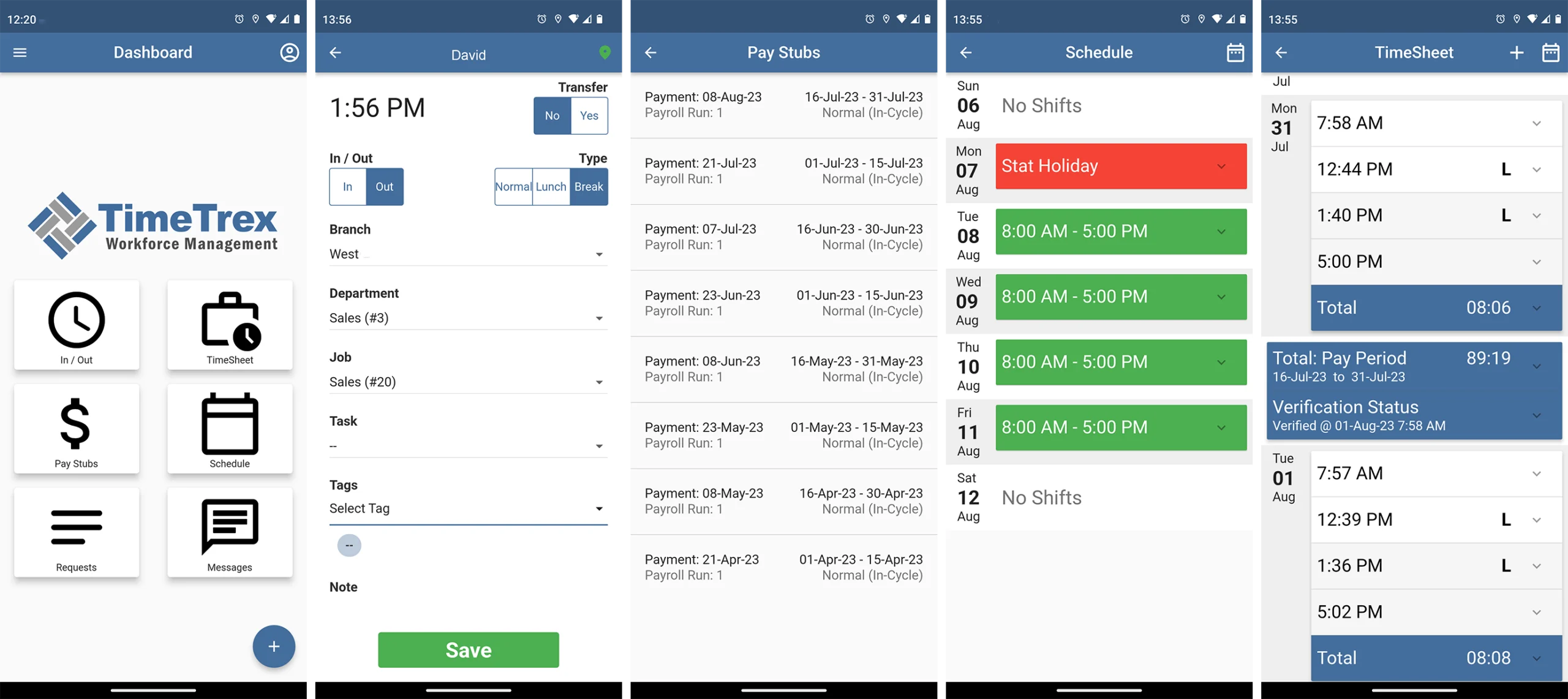
This highlights a clear design choice: the mobile app is perfectly optimized for employee tasks on the go, while the comprehensive web interface remains the command center for complex administrative actions like detailed schedule creation. This ensures each platform is tailored to its primary use case.
The Power User Experience: Managerial Control and Administrative Complexity
For power users—managers and system administrators—the experience is defined by granular control and deep customizability. This user journey embraces the platform's powerful, rule-based engine, which is capable of automating the most complex business policies.
The Manager's View: Oversight and Approvals
For managers, the TimeTrex web interface is a command center for daily workforce oversight. The customizable dashboard provides real-time visibility into team activities. A significant part of a manager's workflow revolves around handling authorizations for time off, punch adjustments, and schedule changes through a multi-level approval hierarchy. The web-based drag-and-drop scheduler is intuitive and can automate complex rotating schedules.
The Administrator's Journey: The Onboarding and Configuration Path
The administrator's experience is the most powerful within the TimeTrex ecosystem. Unlocking this power involves a learning curve, particularly during the initial setup. The process goes beyond a simple wizard, allowing administrators to engage with a deeply layered configuration process. As outlined in the Initial Setup Guide, an admin defines "Policy Building Blocks" to construct precise company rules. This structured procedure, while requiring an initial investment of time, is what enables the system's incredible automation capabilities.
Payroll Processing: A Guided and Precise Workflow
The culmination of the workflow is payroll processing, guided by a dedicated "Payroll Processing Wizard." This tool functions as an interactive checklist, walking the administrator through each step—from confirming authorizations to generating pay stubs—to ensure accuracy. This guided workflow is a major UX strength. The platform excels at calculating tax withholdings and generating year-end forms, ensuring compliance. The final step of tax remittance remains with the business, which is typical for many payroll software platforms that are not full-service payroll providers.
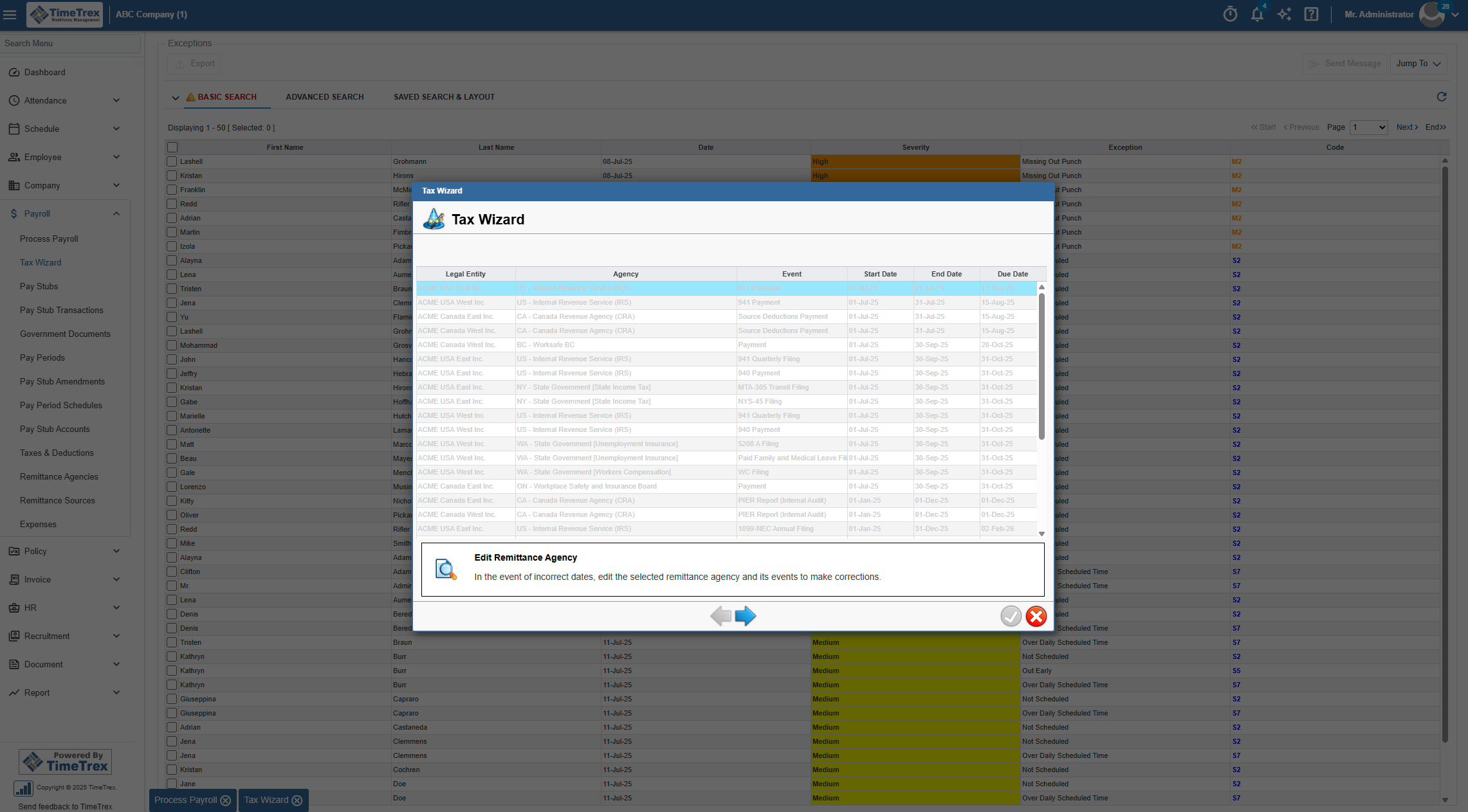
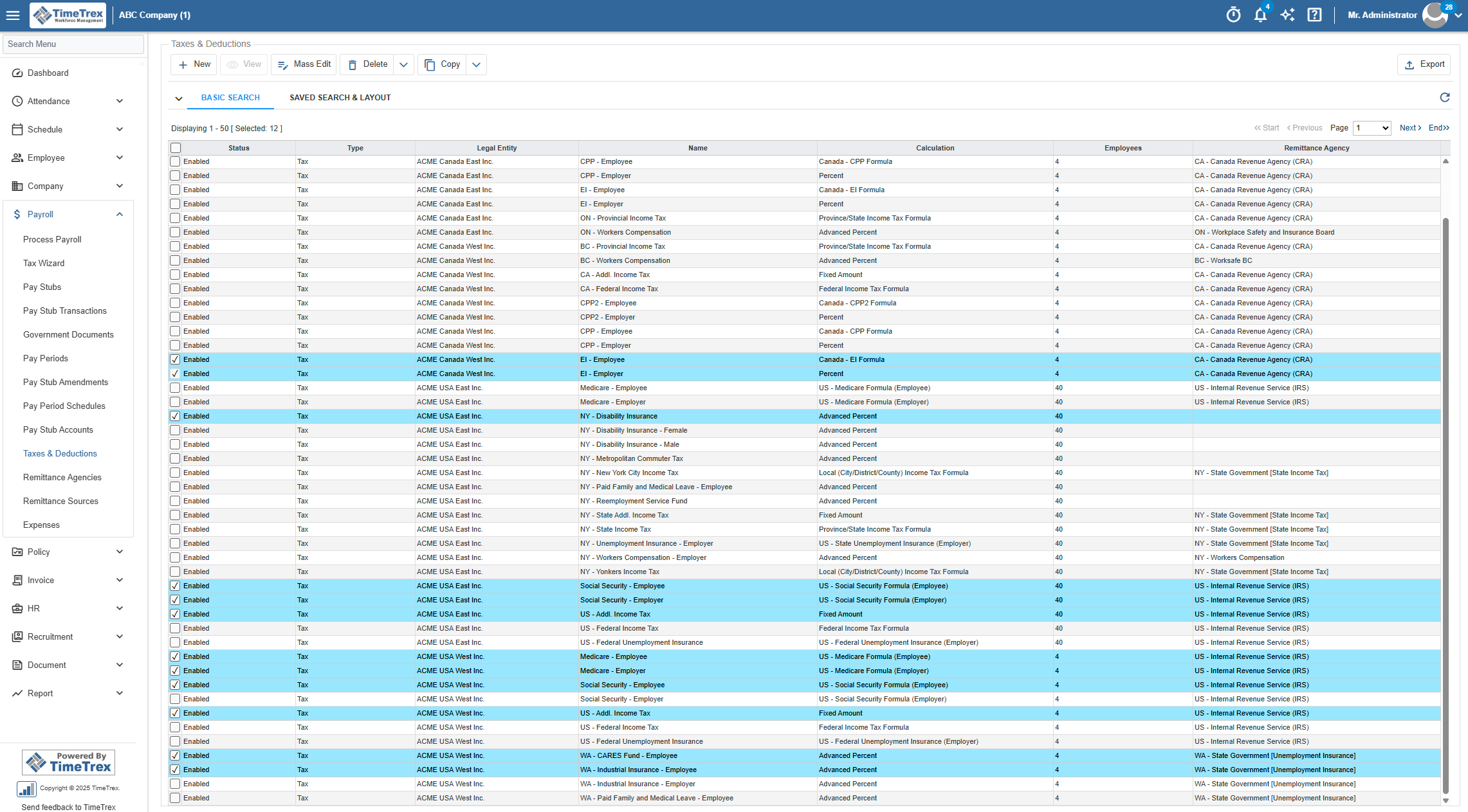
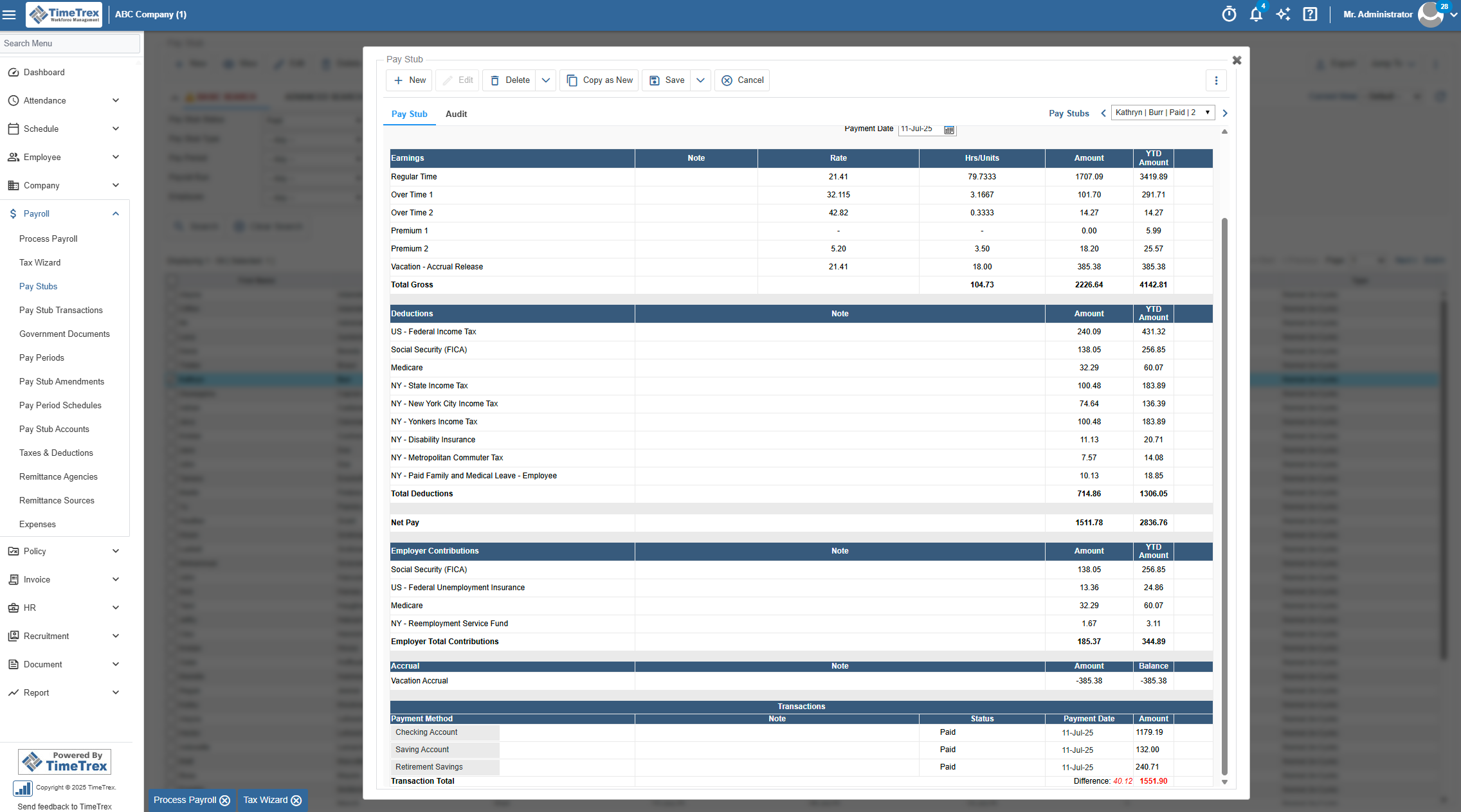
A Synthesis of Market Feedback on Usability
Aggregating reviews from multiple independent sources provides a nuanced picture of how TimeTrex performs in diverse business environments. This synthesis reveals consistent themes, highlighting a clear consensus on its core strengths and learning opportunities.
Common Praises from Users
- All-in-One Convenience and Accuracy: The most frequently cited benefit is the seamless flow of data from time tracking directly into the native payroll module, which saves "countless hours every month" and enhances administrative accuracy.
- Powerful and Flexible Rule Engine: Experienced users appreciate the depth that allows businesses to automate complex business policies, government regulations, and union agreements.
- Helpful and Comprehensive Reporting: The platform's reporting and analytics capabilities are frequently lauded for providing actionable insights into labor costs and productivity trends.
- Responsive and Effective Customer Support: A recurring theme is the high quality of customer support, which is a vital resource for navigating the platform's comprehensive feature set.
Common Feedback and Learning Points
- Rich Administrative Interface: A common point of feedback from new users centers on the administrative interface. Some find that the comprehensive nature of the dashboard can feel busy initially, requiring a period of familiarization to master.
- Focus on Web-Based Management: While the modernized mobile app provides a stellar experience for employees, advanced administrative tasks like schedule creation are intentionally centered in the powerful web interface. This ensures managers have the full suite of tools available when performing complex planning.
- In-Depth Setup Process: The platform's powerful, rule-based engine requires a detailed initial setup. This configuration process, while ensuring precision, is noted by users as being more involved than simpler, less customizable systems.
- Rounding Options: A specific point of feedback from some users involves a desire for even more flexibility in the software's time punch rounding rules to better accommodate unique business cases.
| Aspect | Praises (The Good) | Points of Feedback (The Opportunities) |
|---|---|---|
| Overall Interface | The all-in-one, integrated nature provides a single source of truth and powerful capabilities. | Can feel comprehensive for new users due to the vast number of features, requiring a familiarization period. |
| Core Workflows | The seamless data flow from time tracking to the native payroll module is highly accurate and efficient. | The powerful rule-based engine requires a detailed setup process and has a learning curve. |
| Mobile App | Modern UI praised for advanced employee features like offline mode, GPS tracking, and biometric clock-in. | Advanced management functions like schedule creation are centered in the web interface. |
| Reporting & Analytics | The reporting engine is comprehensive, highly customizable, and provides deep, valuable business insights. | Generating specific reports can take time due to the extensive customization options available. |
| Onboarding & Support | Customer support is consistently rated as responsive, helpful, and knowledgeable. | The platform's power necessitates an upfront investment in learning and configuration. |
Competitive UX Benchmark: TimeTrex in the Market Context
To truly understand whether TimeTrex is "easy to use," its interface must be benchmarked against key competitors. An analysis of Deputy, Connecteam, and Homebase reveals a spectrum of UX philosophies, from simplicity-focused solutions to specialized, mobile-first applications.
TimeTrex vs. Deputy
Deputy is praised for its sophisticated, AI-powered auto-scheduler and clean interface. However, it relies on third-party integrations for payroll, which can't match the reliability of TimeTrex's native, all-in-one system. The choice is between Deputy's scheduling front-end and TimeTrex's robust, reliable back-end architecture with guaranteed data integrity.
TimeTrex vs. Connecteam
Connecteam offers a strong mobile experience for deskless workforces but lacks a native payroll module and has a more complex pricing model. TimeTrex offers a vastly more powerful back-office system—its free Community Edition alone provides enterprise-grade scheduling and payroll far beyond what Connecteam offers.
TimeTrex vs. Homebase
Homebase is designed for "main street" small businesses, prioritizing simplicity above all else. Its interface is clean but lacks advanced features and does not scale well. In the employee scheduling software market, Homebase is easy for basic needs, while TimeTrex offers unparalleled functional depth and customizability for complex operations.
| Feature / Attribute | TimeTrex | Deputy | Connecteam | Homebase |
|---|---|---|---|---|
| Overall Intuitiveness | High | High | High | Very High |
| Onboarding/Setup Complexity | Moderate | Moderate | Low | Very Low |
| Mobile App UX (Manager) | Good Functionality | Inconsistent | Excellent | Good |
| Scheduling Interface | Powerful, Rule-Based | AI-Powered, Visual | Mobile-First, Visual | Simple, Visual |
| Payroll Integration | Native, Fully Integrated | 3rd Party Only | 3rd Party Only | Separate Add-on |
| Dashboard Customization | High (via Dashlets) | Moderate | Low | Low |
| Ideal User Profile | Businesses with Complex Rules & Compliance Needs | Businesses Focused on AI-Powered Demand Forecasting | Deskless, Mobile-First Workforces | Single-Location Small Businesses |
Final Assessment and Strategic Recommendations
The TimeTrex user experience is a formidable tool for workforce management, and its usability is best understood as a trade-off between simplicity and power. It is a complex, feature-rich characteristic that serves different user roles in distinct, effective ways.
Revisiting the "Easy to Use" Claim: A Persona-Based Verdict
- For Employees: TimeTrex succeeds in providing an easy-to-use and empowering experience through its modern mobile app and self-service portal.
- For Managers: The experience is robust and flexible. The web platform offers highly effective tools for deep scheduling and workforce analysis, while the modernized mobile app provides essential on-the-go capabilities for approvals and team monitoring.
- For Administrators: For the system administrator, TimeTrex is best described as a powerful and comprehensive system. It requires a commitment to learning and configuration to unlock its full potential. The platform's "ease" is found in the long-term dividends of operational efficiency, payroll accuracy, and compliance automation.
Ideal User Profile Analysis
TimeTrex is an ideal solution for a specific type of organization:
- Businesses with Complex Rules: Organizations in healthcare, manufacturing, or with union agreements that require a powerful policy engine.
- Organizations Prioritizing Data Integrity: Companies that want to eliminate payroll errors by using a single-database, all-in-one architecture.
- Companies with Technical Resources: Organizations with an in-house administrator who can master the system's logic or are willing to invest in vendor support.
- Budget-Conscious Entities: The TimeTrex Community Edition offers a uniquely powerful, free suite of tools for small businesses, startups, and non-profits.
Final Strategic Recommendations for Evaluation
For any organization considering TimeTrex, the evaluation process must be strategic:
- Prioritize Your Core UX Need: Determine if your priority is rapid deployment and simplicity (alternatives may be suitable) or long-term control and data integrity (TimeTrex is a leading contender).
- Engage in a Hands-On, Administrator-Led Trial: A passive demo is insufficient. The person who will administer the system should personally attempt to configure a core company policy during the trial.
- Assess Internal Resources and Commitment: Honestly assess whether you have a designated individual who can become the in-house platform expert. The power of TimeTrex is directly proportional to the user's ability to master its complexity.
Ready to Take Control of Your Workforce?
Discover how TimeTrex's powerful, all-in-one platform can streamline your scheduling, time tracking, and payroll, all while ensuring compliance and accuracy. See for yourself why businesses with complex needs choose TimeTrex.
Learn More & Get a Free DemoDisclaimer: The content provided on this webpage is for informational purposes only and is not intended to be a substitute for professional advice. While we strive to ensure the accuracy and timeliness of the information presented here, the details may change over time or vary in different jurisdictions. Therefore, we do not guarantee the completeness, reliability, or absolute accuracy of this information. The information on this page should not be used as a basis for making legal, financial, or any other key decisions. We strongly advise consulting with a qualified professional or expert in the relevant field for specific advice, guidance, or services. By using this webpage, you acknowledge that the information is offered “as is” and that we are not liable for any errors, omissions, or inaccuracies in the content, nor for any actions taken based on the information provided. We shall not be held liable for any direct, indirect, incidental, consequential, or punitive damages arising out of your access to, use of, or reliance on any content on this page.
About The Author

Roger Wood
With a Baccalaureate of Science and advanced studies in business, Roger has successfully managed businesses across five continents. His extensive global experience and strategic insights contribute significantly to the success of TimeTrex. His expertise and dedication ensure we deliver top-notch solutions to our clients around the world.
Time To Clock-In
Start your 30-day free trial!
Experience the Ultimate Workforce Solution and Revolutionize Your Business Today
- Eliminate Errors
- Simple & Easy To Use
- Real-time Reporting
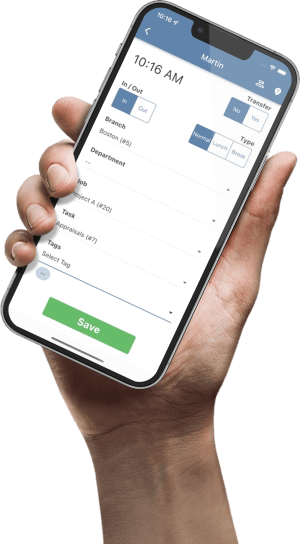
Saving businesses time and money through better workforce management since 2003.
Copyright © 2025 TimeTrex. All Rights Reserved.
